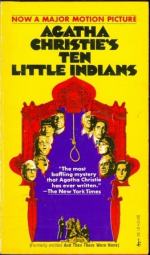|
|
And Then There Were None Author/Context
Agatha Christie, the world's most famous female mystery writer, was born Agatha Miller in 1890. She was raised upper-middle class in Devon, the youngest of three children. An intelligent child, she was tutored at home, never attending public schools. At the age of 24, she married Archie Christie, a British fighter pilot. While he was off at war, she worked as a nurse in an army hospital. During the war, she began working on the novel that would introduce the world to her most famous character, Belgian detective Hercule Poirot. She would finish the novel in 1915, but didn't publish it until 1920. The novel quickly became a best-seller, launching her literary career, which would go on to span some eighty novels and fourteen plays, including 'The Mousetrap", the longest-running play in history. Her second novel was published in 1922, and then for every year afterwards, until her death in 1976, she put out a new book every year, keeping her on the best seller list for most of her adult life.
In 1926, Agatha Christie disappeared for ten days. It was a huge national mystery. She was discovered in a hotel ten days later, suffering from amnesia. She had been under a lot of stress in her life - she was in a difficult marriage and her mother had just died. Two years later she divorced her husband, and two years later she was remarried to an assistant archaeologist named Max Mallowan. Agatha Christie is the best-selling novelist of all time. She's sold more copies than any other author, with the exception of the bible. Her assembled books have only been outsold by the bible. She's considered the creator of the modern mystery story.
And Then There Were None was written during the Second World War, while Agatha was working as hospital dispenser. It is one of her most famous and significant works, considered one of the greatest mysteries ever written. It was lauded at the time for its near unsolvability. Christie was famous for her ability to write incredibly difficult mysteries without ever cheating. She never had a character lie in their thoughts to purposefully mislead the reader. She took pride in being honest with he audience. At most, all she would do is have a character say or thing something that could be taken two ways - if you couldn't figure out the mystery, the clues would be clearly visible the second time around once you knew who the killer was.
And Then There Were None was originally titled 'Ten Little Niggers', but when it was published in the US, the name was changed to 'And Then There Were None'. In the 60s, during a heightened period of sensitivity, the title of the play was changed to 'Ten Little Indians'. Since then, the play has always been titled 'Ten Little Indians', and the novel 'And Then There Were None'. Her most popular novel, 'And Then There Were None' has been has been adapted to the screen more than any other of her works, a total of 9 times, including a Russian version and an Indian version, complete with musical numbers. The novel continues to capture readers' imaginations even today.
Bibliography
Christie, Agatha. An Autobiography. William Collins Sons, Toronto, 1977.
Christie, Agatha. And Then There Were None. St. Martin's Paperbacks edition, New York, 2001.
Morgan, Janet. Agatha Christie, a Biography. William Collins Sons, Toronto, 1984.
Robyns, Gwen. The Mystery of Agatha Christie. Doubleday, Garden City, 1978.




